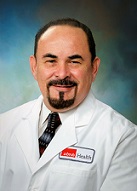Peer Reviewed Cancer



Posted November 21, 2017
Dr. Victor Reyes, University of Texas Medical Branch at Galveston
Dr. Ying Bao, Brigham and Women's Hospital
Stomach Cancer Is a Deadly Disease
According to the American Cancer Society, 28,000 new cases of stomach cancer are expected in 2017 and nearly 40% (11,000) of those patients will die from this disease.1 The World Health Organization (WHO) lists it as the fourth most deadly cancer worldwide.2 Due to the limited investment in stomach cancer research, large knowledge gaps exist, such as early identification of the disease and lack of adequate animal models and biomarkers. Stomach cancer is a disease in which malignant cells initially form in the innermost lining of the stomach and then spread through the outer layers. The majority of stomach cancers are classified as adenocarcinomas, or cancers that begin in cells that make and release mucus and other fluids. Only 27% of patients are diagnosed in the earliest or localized stages of stomach cancer, when the disease is found only in the stomach. The 5-year survival rate in the United States for patients diagnosed in the localized stage of the disease is roughly 67%. However, if the disease spreads to a different part of the body (i.e., the regional or distant stage), that survival rate drops to approximately 30%.3 Treatment options for patients diagnosed with stomach cancer are limited. They include surgery to remove all or part of the stomach and combinations of chemotherapy and radiation.
A large majority of stomach cancer cases are associated with infection caused by the bacteria Helicobacter pylori. According to the Centers for Disease Control and Prevention, roughly two-thirds of the world's population is infected with H. pylori, but most of those individuals either lack symptoms or they develop chronic gastritis (inflammation in the lining of the stomach).4 In a small percentage of people, H. pylori infection leads to stomach cancer. The WHO classifies H. pylori as a Class I carcinogen, the only bacteria thus classified, and the genetic features of the strains associated with stomach cancer are not yet understood.
In addition to the increased risk of stomach cancer associated with H. pylori infection, there are several other factors that slow progress toward understanding and treating this deadly disease. One major hurdle is detecting and diagnosing the cancer early, when cure is still possible. There are few early warning signs, but these are vague and could be attributed to other benign causes. At this time, there are no established screening tests for stomach cancer. As a result, the majority of patients are diagnosed with late-stage, incurable disease. Pinpointing novel biomarkers of early disease will reduce disease mortality and increase the likelihood of curing a patient.
In fiscal year (FY) 2015, Congress answered the call of advocates and added stomach cancer to the Peer Reviewed Cancer Research Program (PRCRP) for funding. To address the gaps in stomach cancer research and patient care, the PRCRP supports multiple studies that, if successful, will provide a valuable resource to the stomach cancer research community and accelerate efforts toward diagnosis and treatment.
How Is the PRCRP Addressing This Global Problem?
From FY15 through FY16, the PRCRP has invested $13,454,782, supporting 19 research projects. The studies funded by the PRCRP are aimed at addressing critical research gaps and unresolved questions within the field of stomach cancer, using both basic science and clinical research techniques. Below are just a few of the questions being addressed by selected PRCRP-funded investigators:
How can we characterize H. pylori strains and detect biomarkers of stomach cancer?

Dr. Victor Reyes, University of Texas Medical Branch at Galveston
H. pylori is linked to several diseases, including chronic gastritis, peptic ulcer disease, and stomach cancer. However, the factors that determine which disease a person develops as a result of H. pylori infection are still unclear and predictive biomarkers are needed. With a FY15 Idea Award with Special Focus, Dr. Victor Reyes at The University of Texas Medical Branch at Galveston is characterizing unique genomic features of various H. pylori strains and identifying candidate biomarkers of stomach cancer development. Molecular responses to infection with various types of H. pylori in the innermost lining of the stomach, where cancer initiates, could represent candidate biomarkers of H. pylori-induced stomach cancer. To date, Dr. Reyes and his team have developed an in vitro model of infection using primary human gastric cells and a panel of H. pylori isolates from various gastric diseases, including stomach cancer. Preliminary data show that different strains of H. pylori display distinct gene expression patterns and elicit host cell responses specific to them. The characterization of those responses may lead to the identification of novel biomarkers for stomach cancer due to H. pylori infection.
How can we improve early detection and diagnosis of stomach cancer?

Dr. Ying Bao, Brigham and Women's Hospital
When cancerous cells develop, it is thought that they must make metabolic adjustments to sustain their unregulated growth, which leaves behind a trail of chemical compounds that may indicate disease progression. Dr. Ying Bao of Brigham and Women's Hospital received a FY15 Career Development Award to determine the metabolic alterations associated with early stomach cancer. Through this work, Dr. Bao is defining a metabolomic "fingerprint" for stomach cancer that can be detected in a blood sample. Using a state-of-the-art metabolomics platform, thousands of metabolites are being analyzed from the blood drawn from patients prior to diagnosis, to potentially identify novel biomarkers of early disease. If successful, this metabolomic fingerprint will be used to diagnose stomach cancer in its early stages, when treatment options are more viable.
Moving Forward, Much More Still Needs to Be Done
Each year, the PRCRP consults with researchers, clinicians, advocates, and survivors to develop a targeted investment strategy that aims to fill critical knowledge and resource gaps within stomach cancer research. Two major gaps in stomach cancer research are the lack of biomarkers for disease prediction and the need to develop screening procedures for early detection. By acknowledging these gaps, the PRCRP can promote impactful research, such as Dr. Bao's work with metabolomics fingerprinting, to improve prevention, detection, treatment, and survivorship. Furthermore, by funding innovative projects like Dr. Reyes' effort focused on H. pylori exposure to address these gaps, advances can be made to help improve the health and well-being of affected individuals, including Service members, their families, and the American public.
Publications:
- Cancer Facts and Figures 2017. American Cancer Society. Atlanta, GA (https://www.cancer.org/content/dam/cancer-org/research/cancer-facts-and-statistics/annual-cancer-facts-and-figures/2017/cancer-facts-and-figures-2017.pdf).
- Cancer Fact Sheet. World Health Organization (http://www.who.int/mediacentre/factsheets/fs297/en/).
- SEER Cancer State Facts: Stomach Cancer. National Cancer Institute. Bethesda, MD (https://seer.cancer.gov/statfacts/html/stomach.html).
- Helicobacter pylori Fact Sheet for Health Care Providers. Centers for Disease Control and Prevention. Atlanta, GA (https://www.cdc.gov/ulcer/files/hpfacts.PDF).
Links:
Public and Technical Abstracts: Plasma Metabolomic Fingerprint of Early Gastric Cancer
Last updated Monday, March 10, 2025














